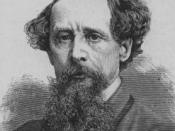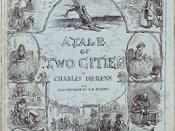In A Tale of Two Cities, by Charles Dickens, the author writes about the social problems in England and what is known today as the French Revolution. The novel is set in 1775, with a comparison of England and France. Both countries battle poverty, injustice, and violence due to the ruling authorities. The French people were tired of the social and economic inequalities enforced by the ruling monarchy. The aristocracy and clergy lived a life of luxury while people in the Third Estate (peasants, artisans, merchants, etc.) paid most of the taxes and didn't have as many rights. Dickens even opens the book with, "It was the best of times, it was the worst of times, it was the age of wisdom, it was the age of foolishness..."(Dickens,1). However, England becomes a safe haven for those escaping the violence of the French Revolution. A Tale of Two Cities reflects stability of England in the eighteen-fifties.
Such examples of this idea are stated throughout the book. When Lucie Manette finds her father, Dr. Manette, in Paris after his eighteen-year imprisonment in the Bastille, she tells him that they will go to England to be at peace and at rest. Charles Darnay also refers to England as his refuge. Jarvis Lorry complains about the difficulties of communication brought about by the Revolution between the London and Paris branches of Tellson's Bank. He explains that the parcels would come and go in England, but in France, everything is stopped. Dr. Manette, Lucie, and Darnay seem unlikely to return to France after their escape to England, not only for political reasons, but also because they are happy and safe in England. Carton even says, "I see the lives for which I lay down my life, peaceful, useful, prosperous...



Interesting
I haven't really thought about this much after reading the book. Good information!
2 out of 2 people found this comment useful.